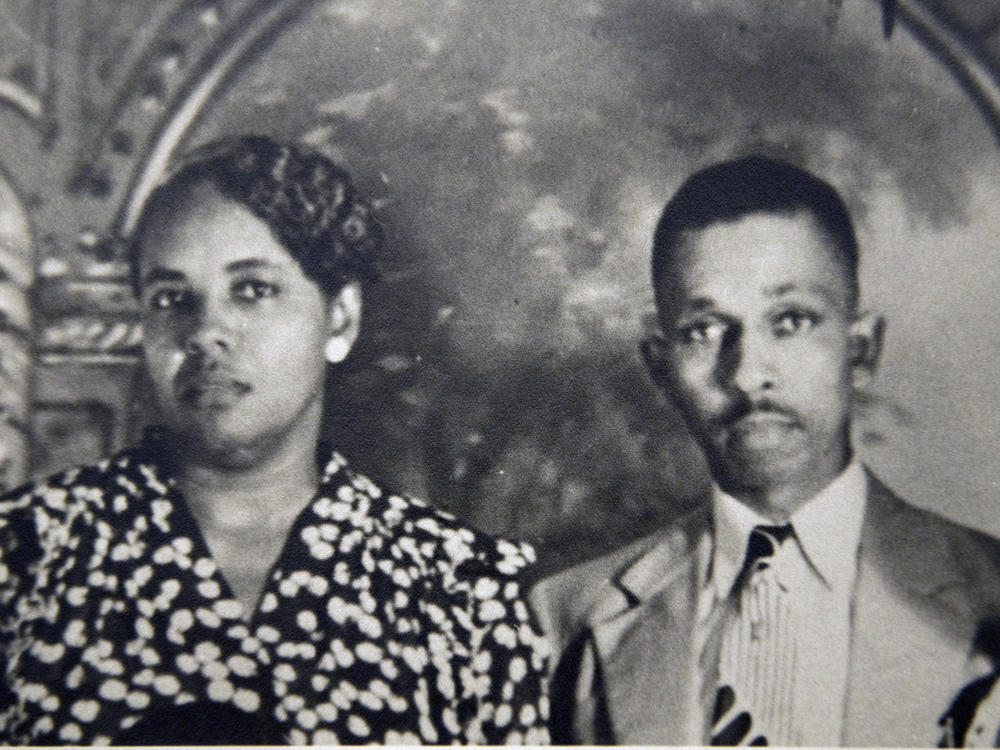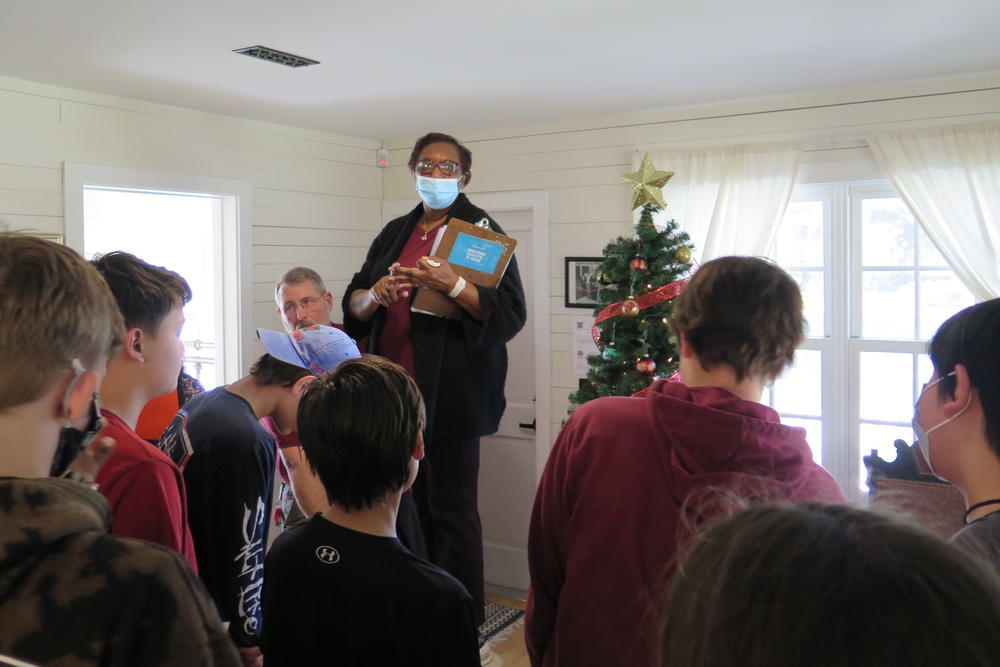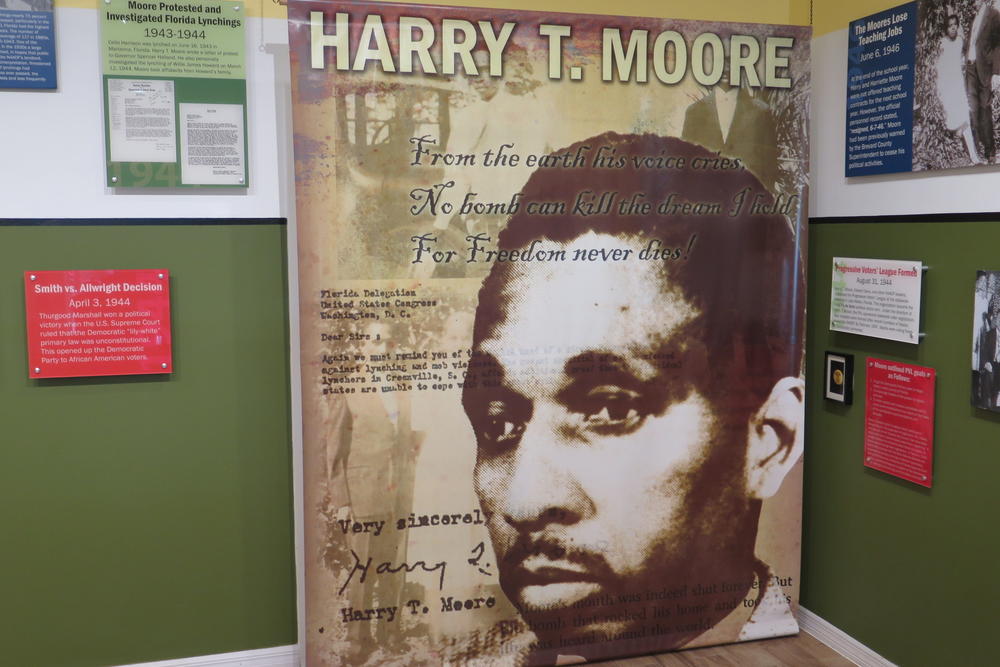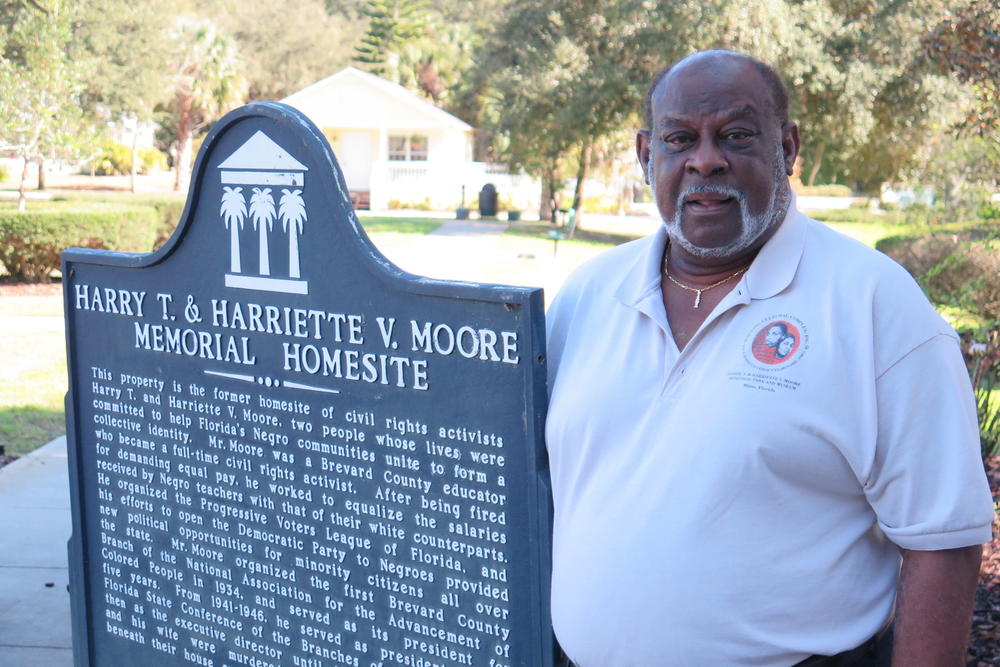Section Branding
Header Content
Remembering the man who 'laid the groundwork for the modern civil rights movement'
Primary Content
Updated February 2, 2022 at 7:48 PM ET
Seventy years ago, one of the first civil rights leaders of the modern era was killed in a bombing in Florida. Harry T. Moore isn't as well known as civil rights icons Medgar Evers or Martin Luther King Jr. Moore's activism began earlier, in the 1930s. His work in Florida investigating lynchings and registering African Americans to vote cost him his life.
He lived and carried out his work from his home in Mims, a small town on Florida's Atlantic coast, where he lived with his wife, Harriette Moore, and two daughters. Today, it's home to the Harry T. & Harriette V. Moore Cultural Complex.
School groups visit almost daily. There's a museum where visitors hear about Harry T. Moore's early history. He and his wife were both teachers who lost their jobs because of Moore's activism. Undeterred, he became the NAACP's executive secretary in Florida, traveling the state, fundraising, organizing chapters and registering voters.
Bill Gary, a former head of the NAACP in Brevard County, says Moore "laid the groundwork for the modern civil rights movement. Moore was fighting for the right to register Black voters. Moore was fighting to get anti-lynching legislation passed. He was fighting to equalize Black and white teachers' salaries."
At the Moore Cultural Complex, there's also a replica of the Moores' house. The original was destroyed in a bombing on Christmas Day in 1951. On a recent tour, dozens of eighth-grade students crowd into the tiny shotgun-style house. Museum guide Aisha Hosey stands on a chair to get their attention. "I want you to know Mr. Moore was an extremely brave man," she says.
Hosey shows the students the 1940s-style kitchen and the Christmas tree still standing like it was the night Moore was killed (his wife died a little over a week later). She talks about why Moore was killed. "He registered voters, and voters are extremely important," she says. "He fought against lynching, and lynching was prevalent."
Visitors in the Moores' time knew Florida for its warm weather, its beaches and its orange groves. But for decades, the state was also the scene of lynchings and violence against African Americans. Anti-Black violence by whites had destroyed communities in Rosewood and Ocoee in the 1920s. Between 1900 and 1930, Florida had the nation's highest number of lynchings per capita.
That's the Florida where Harry T. Moore grew up and decided things had to change. In the 1940s, along with other NAACP leaders, Moore founded the Progressive Voters League, a group that over several years registered more than 100,000 Black voters. He knew voting rights were dangerous and could cost him his life.
Ben Green, author of a book about Moore, Before His Time: The Untold Story of Harry T. Moore, America's First Civil Rights Martyr, says the Ku Klux Klan was active and visible in Florida, especially at election time. "There was just outright intimidation," Green says. "In Lake County, there was [a] klan march on Election Day through the Black neighborhood, basically saying don't even think about going to the polls."
By 1951, a series of racist bombings throughout the state drew national press. It was called the "Florida Terror." In Miami, dynamite was used to bomb synagogues and a housing project that was opened to Black families. Gary, the former Brevard County NAACP head, says the bombings linked to the KKK also hit central Florida. He says, "An ice cream stand in Orlando that was owned by a white couple ... served Black people also. Their store was bombed supposedly by the klan because they stepped outside the Jim Crow boundaries."
During this time, Harry T. Moore was actively campaigning to reverse the conviction of three African American men, the surviving members of the Groveland Four. They had been falsely accused of raping Norma Padgett and beating her husband, Willie Padgett. As the retrial for two of them was set to begin, the sheriff in Lake County, Willis McCall, shot both men, claiming they were trying to escape. One survived.
In the weeks before his death, Moore was working to have McCall removed as sheriff. Green says, "He's calling for McCall to be suspended and tried for murder. As far as white people knew, he was the guy you had to get. He was the Black man who was stirring things up."
Weeks later, Moore was at home in Mims with his wife and oldest daughter on Christmas night when a bomb went off under his bedroom. He and his wife died from the blast. His daughter survived.
The FBI sent a dozen agents to Florida. Their investigation took over a year. But neither the bureau nor a grand jury identified who was responsible, and no one was ever charged for the murders. News about Moore's murder and the investigation quickly disappeared from Florida papers. Green says, "Florida wanted this story to go away. They wanted to get this story off the front pages. It was hurting tourism, all those bombings in Miami and Orlando."
It was 1951, three years before the Supreme Court's Brown v. Board of Education decision, which sparked a new era in the civil rights movement. Moore's story and accomplishments were largely forgotten in Florida.
In 2005, as he prepared to run for governor, Florida Attorney General Charlie Crist reopened the investigation of Moore's murder, relying mostly on the extensive FBI file. He named four klansmen, all long dead, as the murderers. Others, though, are skeptical that the murders have truly been solved.
When asked about it, Gary calls it debatable. He says circumstantial evidence is strong that the four KKK members were involved. But if so, he says, it's likely they were part of a larger conspiracy. "And that's a question," he says, "that ... may never be answered, as to who initiated the plot to kill him."
Seventy years after the Moores' deaths, Gary is encouraged that Florida is beginning to address injustices that are part of its racist past. Last year, Florida formally exonerated the Groveland Four. Brevard County's school board acknowledged the unjust firings of Harry and Harriette Moore and reinstated them as teachers. It also adopted a curriculum for elementary and high school students that includes field trips and classes on the Moores and their accomplishments.
At the same time, Gary says some still want to censor history. He's concerned about a bill promoted by Florida's governor that would ban teachers from discussing subjects that would make white students feel "guilt" or "discomfort" on account of their race. He's blunt in his assessment. "Legislation of this sort is the same legislation that was passed during [the] Jim Crow era," Gary says. "It is to suppress and control people. It is to provide your own narrative."
If it becomes law, Gary doesn't think the bill will affect the newly adopted curriculum. Students who visit on field trips don't express guilt or discomfort, he says. Their main questions are: Who killed Harry T. Moore, and why wasn't anyone brought to justice?
Copyright 2022 NPR. To see more, visit https://www.npr.org.
Bottom Content





